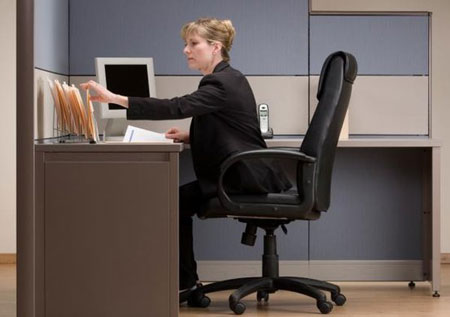5 Tips & exercises to help your back pain while at work. #1: Perform
Sherwin Nicholson | Updated Dec 4, 2020
Continued from: 5 Things you can do if your back hurts at work
It should be one of the first things you do as you get into your seat. By doing it, you are already getting into the mindset of consciously creating the right settings for your lumbar health.
It’s not perfect but it’s a lot healthier than just plopping into your chair, relaxing and hammering away at the keyboard. If this is the first thing that you do, then you are unfortunately missing out on the opportunity to think about your back. You’re likely to forget about your health and won’t realize you’re getting sore again.
Perform! Like a Pianist.
Watch a professional pianist assume their position before they sit for their performance and during. It seems effortless for them to sit without any back support. Any you know that they are professionals when it comes to sitting at their job!
They are very exact in how they do it.
- They sit with their knees shoulder width apart
- Spine straight
- Chin tucked in
- Shoulders back
- They support themselves without a backrest
I bet at this very moment in this article, you may be altering your posture!
Here is something you should take special note of if your back hurts
In order for a Pianist to master their musical art form:
- They must sit for hundreds to thousands of hours
- They sit without ANY back support
- Their seating arrangement is nothing more than a flat bench with minimal padding (if any)
- They place their hands on the piano keys just as you do at work
- They don’t move their lower body at all
- They must look down almost all of the time
- They sit for very long hours in this position and don’t fatigue
Any the final point: They suffer almost NO BACK PAIN.
I know that you could say that office workers are a different circumstance because of even longer hours.
But a Pianist would NEVER allow themselves to sit like an office worker or perform in an office chair while practicing or performing.
You Perform too, so use the Pianist mindset
Use the above bullet points to change the way that you sit at work in your office chair.
Don’t feel like a stressed worker waiting for the workday to end.
You’re performing too, so value your physical health and sit just as a pianist, drummer, cellist and many more do!
Once you get into this 1st action ASAP you’ll be making a HUGE difference in how you’ll feel both mentally and physically. It’s not perfect (as sitting has it’s drawbacks) but it is better than what you have been doing.
Are you getting fatigued?
Yes. Sitting like a Pianist is quite fatiguing at first and that backrest of your office chair feels amazing.
But don’t forget about the analogy that I mentioned in the previous post about relaxing your neck.
Have you ever woken up with your pillow in the wrong place under your head or without any pillow support and your neck felt like it was seized up in pain? A backrest can invite that very injury if you rely on it too often.

Pace yourself. You’re a Musician in Training
Remember, it’s the pianists who got it right the first time so they are not in pain
You on the other hand are trying to reverse the process of your current injury. So it’s going to take longer for you to feel better. This means that you may have to be more patient so that you can experience the same benefits.
Immediately get into your seat using this method while applying the following:
- Try to focus on how long you can sit without the backrest
- Use the upright lumbar rest only when you need to
- Minimize how long you use the backrest
- Stand up or walk to work off the fatigue
- Use the muscles of your back to keep your spine straight
Here is a quick recap of what to do:
- Sit without the upright lumbar rest
- Knees apart
- Spine straight
- Chin down
- Stand or walk when fatigued
- Use the backrest occasionally
What about a lumbar support?
Lumbar supports are wonderful aren’t they?
But it is likely that you are using one now and still could use some more support.
I believe that if you are strictly relying on your support, you aren’t taking advantage of the other suggestions that are available here.
My advice about lumbar supports is that you should use them as a guide of how you should keep your spine aligned and upright while laying against it as lightly as possible. They are more of a subtle reminder of what to do rather than just using them as a rest.
Be patient with your new posture
It’ll take a lot of getting used to and you will feel tired from the new adjustments. If you find this new posture difficult to do, then it is a good indication of how much retraining and reconditioning you’ll need to get better.
Stay focused and positive. Your WILL get better.
Begin Tip & Exercise #2: STAND
For more help:
10 simple 1 minute exercise to help you now
It’s the little changes that you make that will change and improve your back. You can’t solve everything that’s wrong with one magic bullet. Don’t get fooled into those pursuits. It takes a lot of hard work and focus.
Please check out all the resources here to help you one day at a time. There is always something you can learn!


